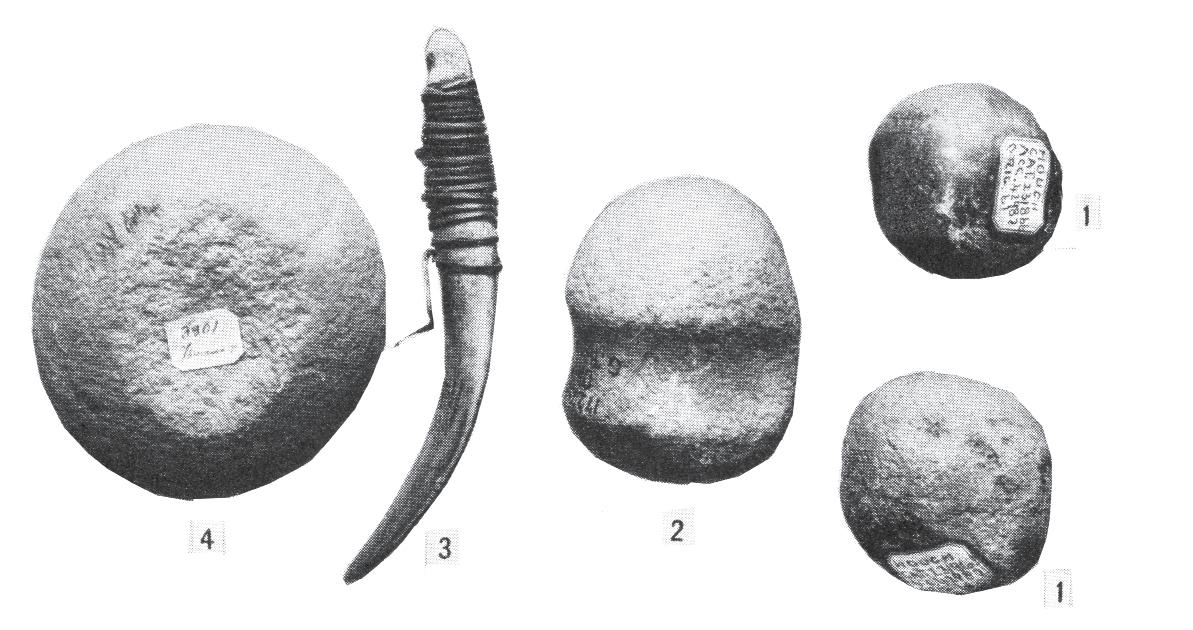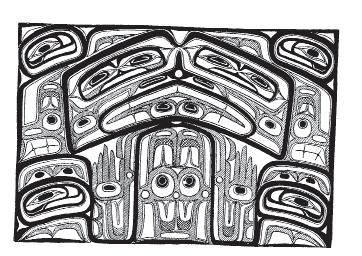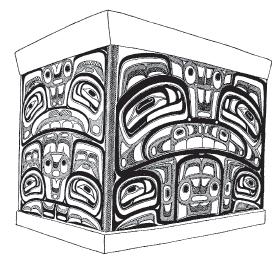
12 minute read
Thought Experiment

Look around the classroom. Consider that if you had lived in the era of foragers, you wouldn’t have had to go to school, you would never have been inside a square-shaped room, and you’d probably all be outside searching for nuts, berries, or deer. Well, maybe not all of you. At least half would no longer be alive, because about 50 percent of children died by the age of ten. If you were one of the lucky ones to have survived, imagine how it would feel to lose siblings so often and so young.
Advertisement
took place among our hominid (erect bipedal primate mammals comprising recent humans and extinct ancestral and related forms) ancestors or among other large animal species. To give just one example, the Acheulian hand axes (a type of stone tool originating in Africa almost 2 million years ago) used by our immediate ancestors, Homo ergaster, changed little during a million and more years. Yet, during the 200,000 years or more of the era of foragers, our ancestors created a remarkable variety of new technologies and new lifeways. Indeed, the relatively sudden replacement of Acheulian stone technologies by more varied and precisely engineered stone tools in Africa from about 200,000 years ago is one of the most powerful reasons for thinking that modern humans existed by that date. Many of these new stone tools were so small that they may have been hafted (bound to handles), which would have greatly increased their versatility and usefulness.
The technological creativity of our foraging ancestors enabled them to explore and settle lands quite different from those in which they had evolved. Indeed, this creativity is one of the most decisive differences between our species and other species, including our closest relatives, the great apes. As far as we know, the great apes have not managed to modify their behaviors enough to migrate into new habitats. This fact is precisely why we do not customarily think of these species as having histories in the way that humans have a history. In contrast, the history of our species during the era of foragers is a story of many unrecorded migrations into new environments, made possible by tiny technological changes, the accumulation of new knowledge and skills, and minor adjustments in lifeways.
As humans spread over more and more of the Earth, human numbers surely increased. Estimates of populations during the era of foragers are based largely on guesswork, though genetic evidence suggests that human numbers shrank to just a few thousands about 70,000 years ago. One of the more influential recent estimates by demographer Massimo Livi-Bacci suggests that thirty thousand years ago there were a few hundred thousand humans, but by ten thousand years ago there may have been as many as 6 million. If we assume that approximately 500,000 humans existed thirty thousand years ago, this implies a growth rate between thirty thousand and ten thousand years ago of less than 0.01 percent per annum, which implies that human populations were doubling approximately every eight thousand to nine thousand years. This rate of growth can be compared with an average doubling time of about fourteen hundred years during the agrarian era and eighty- five years during the modern era.
Technological Change
Rates of growth during the era of foragers are striking in two contradictory ways. Insofar as population growth is an indirect sign of technological innovation, it provides evidence for innovation throughout the era and some signs that innovation was accelerating. By comparison with later eras of
Thought Experiment

What does the “doubling time” of a population really mean? Consider the population growth rate of 0.01 percent per year—which is the assumption made for the populations of thirty thousand years ago. To understand what doubling time at this growth rate would mean, imagine this scenario: there is a village of eleven people, just enough for a soccer team. But they would like to play another team, and they don’t know of any other humans. At this rate of reproduction how long would they have to wait before there are twenty-two people around? Answer: nine thousand years. (More if they think there are going to have to be substitutes!) human history, however, rates of growth were extremely slow. This difference is partly because exchanges of information were limited by the small size and the wide dispersion of foraging communities. Indeed, change occurred so slowly that a person could hardly notice it within a single lifetime, and this fact may mean that ancient foragers had little sense of long-term change, seeing the past mainly as a series of variations on the present.
Migrations into new environments requiring new technologies and new skills probably began quite early during the era of foragers, while all humans still lived within the African continent. Unfortunately, studying technological change during the earliest stages of human history is difficult because surviving objects tell us little about the technological knowledge of those who made them. Today we depend upon objects such as cars and computers, which embody a colossal amount of specialized knowledge. Modern anthropological studies suggest, however, that among foragers knowledge was primarily carried in the head rather than embodied in objects. Thus, the tools that foragers left behind can give us only the palest impression of their technological and ecological skills.
Nevertheless, the evidence of change is powerful. The first piece of evidence that humans were migrating into new environments is the fact that human remains start appearing in all parts of the African continent. By 100,000 years ago some groups had learned to live off the resources of seashore environments, such as shellfish, whereas others were adapting to lifeways in tropical forests and deserts. Evidence that communities exchanged objects over distances up to several hundred kilometers suggests that communities were also exchanging information over considerable distances, and these exchanges may have been a vital stimulus to technological experimentation.
Migrations from Africa
From about 100,000 years ago some humans began to settle outside Africa. Communities of modern humans appeared in southwestern Asia, and from there humans migrated west and east to the southern, and warmer, parts of the Eurasian landmass. These migrations took humans into environments similar to those of their African homeland, so they do not necessarily indicate any technological breakthroughs. Indeed, many other species had made similar migrations between Asia and Africa. The appearance of humans in ice age Australia by forty thousand to fifty thousand years ago, however, is a clear sign of innovation because traveling to Australia demanded sophisticated seagoing capabilities, and within Australia humans had to adapt to an entirely novel biological realm. We know of no other mammal species that made this crossing independently.
Equally significant is the appearance of humans in Siberia from about thirty thousand years ago. To live in the steppes (vast, usually level and treeless tracts) of Inner Asia during the last ice age, you had to be extremely good at hunting large mammals such as deer, horse, and mammoth because edible plants were scarcer than in warmer climates. You also had to be able to protect yourself from the extreme cold by using fire, making close- fitting clothes, and building durable shelters. By thirteen thousand years ago humans had also reached the Americas, traveling either across the ice age land bridge of Beringia, which linked eastern Siberia and Alaska, or by sea around the coasts of Beringia. Within two thousand years of entering the Americas, some groups had reached the far south of South America.
Each of these migrations required new technologies, new botanical and biological knowledge, and new ways of
Topics for Further Study Extinctions
Migrations in Afro-Eurasia, Asia, and Europe
Population Growth Technology
Thought Experiment

If your community moved an average of just ten miles (sixteen kilometers) a year, consider how many years would it take to travel from Africa through Russia and Siberia, to Alaska and then down through the Americas to Tierra del Fuego? Migrations needed advances in technology to be successful. Then imagine what new knowledge you would need as you traveled from Africa (with its warm climates and abundant vegetation and animal life), to Siberia (with cold climates, scarce vegetation but lots of large animals such as mammoth), to North America (with its huge forests and unfamiliar animals and plants), through the tropical lands of Central America and then through the Andes to Tierra del Fuego?
living; thus, each represents a technological breakthrough, within which numerous lesser technological adjustments took place as communities learned to exploit the particular resources of each microregion. No evidence indicates that the average size of human communities increased, however. During the era of foragers technological change led to more extensive rather than more intensive settlement; humans settled more of the world, but they continued to live in small nomadic communities.
Human Impacts on the Environment
The technological creativity that made these migrations possible ensured that, although foragers normally had a limited impact on their environments, their impact was increasing. The extinction of many large animal species (megafauna) and the spread of what is known as “fi re- stick farming” provide two spectacular illustrations of the increasing human impact on the environment, although controversy still surrounds both topics.
Megafaunal Extinctions
Within the last fi fty thousand years many species of large animals have been driven to extinction, particularly in regions newly colonized by humans, whether in Australia, Siberia, or the Americas. Australia and the Americas may have lost 70–80 percent of all mammal species weighing more than 100 pounds (45 kilograms). These species included giant kangaroos and wombats in Australia, mammoth and wooly rhinos in ice age Siberia, horses, camels, giant sloths and saber- toothed tigers in the Americas. Europe may have lost 40 percent of large- animal species; whereas Africa, where humans and large mammals had co- existed for much longer, lost only about 14 percent. As archaeologists pinpoint the date of these extinctions more precisely, the extinctions appear to coincide with the first arrival of modern humans, increasing the probability that they were caused by humans.
Similar extinctions during recent centuries, such as the extinction of the ostrich- sized birds known as “moas” in New Zealand, offer a modern example of what may have happened as humans with improved hunting techniques and skills encountered large animals who had little experience of humans and whose low reproduction rates made them particularly vulnerable to extinction. The loss of large- animal species in Australia and the Americas shaped the later histories of these regions because the lack of large animals meant that humans were unable to exploit large animals as beasts of burden and sources of foodstuffs and fibers.
Fire-Stick Farming
A second example of the increasing environmental impact of early foragers is associated with what the Australian archaeologist Rhys Jones called “fire- stick farming.” Fire- stick farming is not, strictly, a form of farming at all. However, it is, like farming, a way of manipulating the environment to increase the productivity of animal and plant species that humans find useful. Fire- stick farmers regularly burn off the land to prevent the accumulation of dangerous amounts of fuel. Regular firing also clears undergrowth and deposits ash. In effect, it speeds up the decomposition of dead organisms, which encourages the growth of new shoots that can attract grazing animals and the animals that prey on them. Within days or weeks, hunters could return to the land they had fired and expect to find many new plants as well as lots of animals grazing them.
Humans systematically fired the land on all the continents they settled, and through time the practice probably transformed local landscapes and altered the mix of local animal and plant species. In Australia, for example, fire- stick farming through tens of thousands of years probably encouraged the spread of eucalyptus at the expense of species that were less comfortable with fire, creating landscapes very different from those encountered by the earliest human immigrants.
Picking up the Pace
From about fifty thousand years ago the rate of technological change began to accelerate. Migrations to new continents and new environments are one sign of acceleration. New technologies and techniques also proliferated, however. Stone tools became more precise and more varied, and many may have been hafted. People began to use new materials such as bone, amber, and vegetable fibers. From about thirty thousand to twenty thousand years ago, new and more sophisticated tools appeared, including bows and arrows and spear throwers.
Foragers in tundra (level or rolling treeless plain that is characteristic of arctic and subarctic regions) regions used bone needles to make carefully tailored clothes from animal skins; sometimes they covered their clothing with elaborate ornamentation made from animal teeth or shells. The remains of prey species show that hunters, particularly in cold climates, became more specialized in their hunting techniques, which suggests that their understanding of different environments was becoming more and more sophisticated. Cave paintings and sculptures in wood or bone began to appear in regions as disparate as Africa, Australia, Mongolia, and Europe.
Affluent Foragers
Accelerating technological change accounts for one more development that foreshadowed the changes that would eventually lead to the agrarian era. Most foraging technologies can be described as “extensive.” They allowed humans to occupy larger areas without increasing the size of individual communities. Occasionally, though, foragers adopted more intensive techniques, that is to say techniques that allowed them to extract more resources from a given area. This allowed them to create larger and more sedentary (settled) communities. Evidence for such changes is particularly common from about twenty thousand to fifteen thousand years ago and is best known from the corridor between Mesopotamia (the region of southwestern Asia between the Tigris and Euphrates Rivers) and the Nile Valley— the region that links Africa and Eurasia. Anthropologists have long been aware that foragers living in environments of particular abundance will sometimes become less nomadic and spend longer periods at one or two main home bases. They may also become more sedentary if they devise technologies that increase the output of resources from a particular area. Anthropologists refer to such foragers as “affluent foragers.”
The examples that follow are taken from Australia, where foraging lifeways can be studied more closely because they have survived into modern times. During the last five thousand years new, smaller, and more finely made stone tools appeared in many parts of Australia, including small points that people may have used as spear tips. Some tools were so beautifully made that they were traded as ritual objects over hundreds of miles. New techniques meant new ways of extracting resources. In the state of Victoria people built elaborate eel traps, some with canals up to 300 meters long. At certain points people constructed nets or tapered traps, using bark strips or plaited rushes, to harvest the trapped eels. So many eels could be kept in these “eel farms” that relatively permanent settlements appeared nearby. One site contains almost 150 small huts built of stone. In addition to eels, the inhabitants of these small settlements lived off local species of game, from emu to kangaroo, as well as local vegetable foods such as daisy yam tubers, ferns, and convolvulus (herbs and shrubs of the morning glory family).
Some communities began to harvest plants such as yams, fruit, and grains in ways that suggest early steps toward agriculture. Yams were (and are today) harvested in ways that encouraged re- growth, and people deliberately planted fruit seeds in refuse heaps to create fruit groves. In some of the more arid areas of central Australia, early European travelers observed communities harvesting wild millet with stone knives and storing it in large haystacks. Archaeologists have discovered grindstones that were used to grind seeds as early as fifteen thousand years ago in some regions. In many coastal regions of Australia people fished using shell hooks and small boats, and fishing enabled them to live in denser and more populous communities. In general, the coasts were more thickly settled than inland areas.


The appearance of communities of affluent foragers prepared the way for the next fundamental transition in human history: the appearance of communities that systematically manipulated their environments to extract more resources from a given area. The set of technologies that these people used is often called “agriculture”; we refer to the era in which agriculture was the most important basic technology as the “agrarian era.”
The Era of Foragers in World History
Historians have often assumed that little changed during the long era of foragers. In comparison with later eras of human history this assumption may seem to be true. It is also true that change was normally so slow that it was imperceptible within a single lifetime; thus, few men and women in the era of foragers could have appreciated the wider significance of technological changes. Nevertheless, in comparison with the pace during the prehuman era, the pace of technological change during the era of foragers was striking. Exploiting the technological synergy (the creative power generated by linking people through language) that was made available to humans by their capacity for symbolic language, human communities slowly learned to live successfully in a wide variety of new environments. A gradual accumulation of new skills allowed foraging communities to settle most of the world in migrations that had no precedent either among other primate species or among our hominid ancestors.
During the course of 250,000 years the pace of change was slowly accelerating. During the last fifty thousand years or so, the variety and precision of foraging technologies and techniques multiplied throughout the world. Eventually foraging technologies became sophisticated enough to allow groups of people in some regions to exploit their surroundings more intensively, a change that marks the first step toward agriculture.


